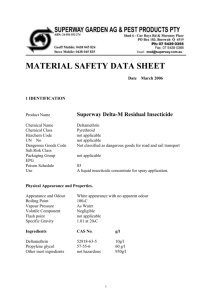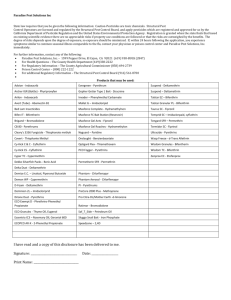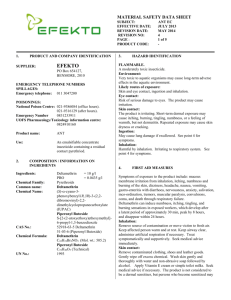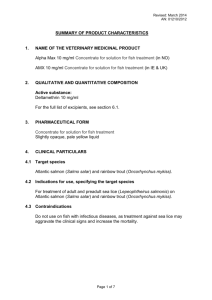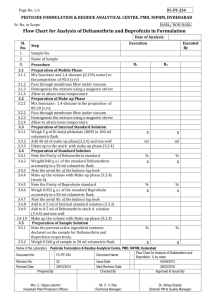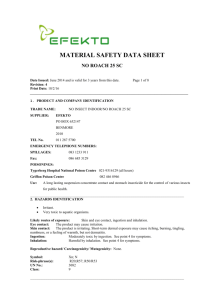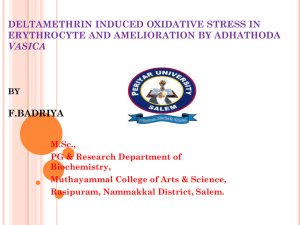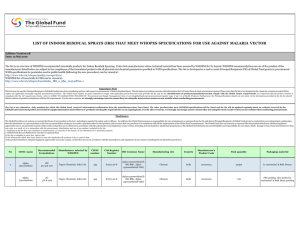Determination of Deltamethrin in Cattle Dipping Baths by High
advertisement
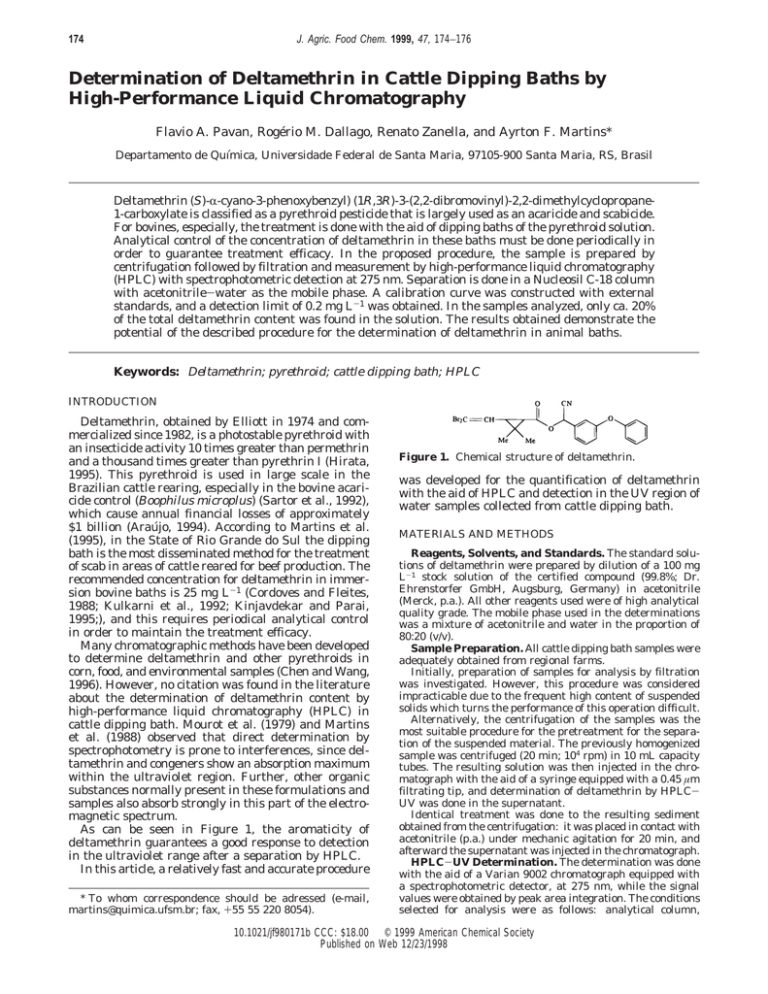
174 J. Agric. Food Chem. 1999, 47, 174−176 Determination of Deltamethrin in Cattle Dipping Baths by High-Performance Liquid Chromatography Flavio A. Pavan, Rogério M. Dallago, Renato Zanella, and Ayrton F. Martins* Departamento de Quı́mica, Universidade Federal de Santa Maria, 97105-900 Santa Maria, RS, Brasil Deltamethrin (S)-R-cyano-3-phenoxybenzyl) (1R,3R)-3-(2,2-dibromovinyl)-2,2-dimethylcyclopropane1-carboxylate is classified as a pyrethroid pesticide that is largely used as an acaricide and scabicide. For bovines, especially, the treatment is done with the aid of dipping baths of the pyrethroid solution. Analytical control of the concentration of deltamethrin in these baths must be done periodically in order to guarantee treatment efficacy. In the proposed procedure, the sample is prepared by centrifugation followed by filtration and measurement by high-performance liquid chromatography (HPLC) with spectrophotometric detection at 275 nm. Separation is done in a Nucleosil C-18 column with acetonitrile-water as the mobile phase. A calibration curve was constructed with external standards, and a detection limit of 0.2 mg L-1 was obtained. In the samples analyzed, only ca. 20% of the total deltamethrin content was found in the solution. The results obtained demonstrate the potential of the described procedure for the determination of deltamethrin in animal baths. Keywords: Deltamethrin; pyrethroid; cattle dipping bath; HPLC INTRODUCTION Deltamethrin, obtained by Elliott in 1974 and commercialized since 1982, is a photostable pyrethroid with an insecticide activity 10 times greater than permethrin and a thousand times greater than pyrethrin I (Hirata, 1995). This pyrethroid is used in large scale in the Brazilian cattle rearing, especially in the bovine acaricide control (Boophilus microplus) (Sartor et al., 1992), which cause annual financial losses of approximately $1 billion (Araújo, 1994). According to Martins et al. (1995), in the State of Rio Grande do Sul the dipping bath is the most disseminated method for the treatment of scab in areas of cattle reared for beef production. The recommended concentration for deltamethrin in immersion bovine baths is 25 mg L-1 (Cordoves and Fleites, 1988; Kulkarni et al., 1992; Kinjavdekar and Parai, 1995;), and this requires periodical analytical control in order to maintain the treatment efficacy. Many chromatographic methods have been developed to determine deltamethrin and other pyrethroids in corn, food, and environmental samples (Chen and Wang, 1996). However, no citation was found in the literature about the determination of deltamethrin content by high-performance liquid chromatography (HPLC) in cattle dipping bath. Mourot et al. (1979) and Martins et al. (1988) observed that direct determination by spectrophotometry is prone to interferences, since deltamethrin and congeners show an absorption maximum within the ultraviolet region. Further, other organic substances normally present in these formulations and samples also absorb strongly in this part of the electromagnetic spectrum. As can be seen in Figure 1, the aromaticity of deltamethrin guarantees a good response to detection in the ultraviolet range after a separation by HPLC. In this article, a relatively fast and accurate procedure * To whom correspondence should be adressed (e-mail, martins@quimica.ufsm.br; fax, +55 55 220 8054). Figure 1. Chemical structure of deltamethrin. was developed for the quantification of deltamethrin with the aid of HPLC and detection in the UV region of water samples collected from cattle dipping bath. MATERIALS AND METHODS Reagents, Solvents, and Standards. The standard solutions of deltamethrin were prepared by dilution of a 100 mg L-1 stock solution of the certified compound (99.8%; Dr. Ehrenstorfer GmbH, Augsburg, Germany) in acetonitrile (Merck, p.a.). All other reagents used were of high analytical quality grade. The mobile phase used in the determinations was a mixture of acetonitrile and water in the proportion of 80:20 (v/v). Sample Preparation. All cattle dipping bath samples were adequately obtained from regional farms. Initially, preparation of samples for analysis by filtration was investigated. However, this procedure was considered impracticable due to the frequent high content of suspended solids which turns the performance of this operation difficult. Alternatively, the centrifugation of the samples was the most suitable procedure for the pretreatment for the separation of the suspended material. The previously homogenized sample was centrifuged (20 min; 104 rpm) in 10 mL capacity tubes. The resulting solution was then injected in the chromatograph with the aid of a syringe equipped with a 0.45 µm filtrating tip, and determination of deltamethrin by HPLCUV was done in the supernatant. Identical treatment was done to the resulting sediment obtained from the centrifugation: it was placed in contact with acetonitrile (p.a.) under mechanic agitation for 20 min, and afterward the supernatant was injected in the chromatograph. HPLC-UV Determination. The determination was done with the aid of a Varian 9002 chromatograph equipped with a spectrophotometric detector, at 275 nm, while the signal values were obtained by peak area integration. The conditions selected for analysis were as follows: analytical column, 10.1021/jf980171b CCC: $18.00 © 1999 American Chemical Society Published on Web 12/23/1998 Determination of Deltamethrin by HPLC J. Agric. Food Chem., Vol. 47, No. 1, 1999 175 Table 1. Distribution of Deltamethrin in the Different Fractions of the Samples (Cattle Dipping Bath)a a samples sediments (g L-1) bath A bath B bath C 43.4 8.9 16.3 deltamethrin in sedimentb (mg L-1) (%) deltamethrin in solution (mg L-1) (%) 9.4 ( 0.1 1.0 ( 0.0 0.2 ( 0.0 19.3 ( 0.4 9.8 ( 0.5 7.7 ( 0.7 39.2 ( 0.6 9.2 ( 0.2 2.4 ( 0.1 80.7 ( 0.4 90.2 ( 0.5 92.3 ( 0.7 Number of replicates (n) ) 3. b Extractable by solvents. Table 2. Results from the Recovery Assays (within Days) sedimentable material (g L-1) deltamethrin in solution (mg L-1) added deltamethrin (mg L-1) bath D 14.2 0.4 ( 0.0 bath E 28.3 1.0 ( 0.0 bath F 21.5 1.3 ( 0.0 25.5 51.1 25. 5 51.1 25.5 51.1 25.5 51.1 sample <LD distilled water (blank) a recovered deltamethrin (%)a in solution in sediment 4.6 ( 0.1 9.3 ( 0.2 23.0 ( 0.5 32.1 ( 0.1 20.6 ( 0.6 28.9 ( 0.4 95.7 ( 0.5 96.5 ( 0.3 77.9 ( 0.8 75.7 ( 0.6 58.1 ( 1.7 52.6 ( 0.5 60.4 ( 1.6 55.7 ( 0.9 total recovery (%) 82.4 85.0 81.2 84.7 81.0 84.6 95.7 96.5 x ( sx; n ) 3. Table 3. Results from the Recovery Assays (Day-to-Day) sample sedimentable material (g L-1) deltamethrin in solution (mg L-1) added deltamethrin (mg L-1) bath D 14.2 0.4 ( 0.0 25.5 51.1 a recovered deltamethrin (%)a in solution in sediment 4.5 ( 0.2 9.2 ( 0.4 78.1 ( 0.9 75.4 ( 0.8 total recovery (%) 82.6 84.6 x ( sx; n ) 3. Figure 2. Deltamethrin HPLC-UV chromatograms: (a) 25 mg L-1 solution of certified standard deltamethrin (in acetonitrile p.a.) and (b) fortified sample of dipping bath with 25 mg L-1 deltamethrin commercial solution. Conditions: Varian 9002 chromatograph; Nucleosil C-18 column [(250 + 40) × 4 mm i.d., 5 µm]; mobile phase (1 mL min-1), acetonitrile-water (80:20,v/v); degassed with helium; injected volume, 35 µL; wavelength, 275 nm; retention time, 11.2 min. Nucleosil C-18 [(250 + 40) × 4 mm i.d., 5 µm]; mobile phase (1 mL/min), acetonitrile-water (80:20, v/v); degassed with helium; injected volume, 35 µL. The deltamethrin quantification was done by external standards using multiple points. The calibration curve equation was determined by the same selected chromatographic conditions and corresponds to y ) 2603.8 x + 1022.8 (r ) 0.9993) where y ) peak area, x ) deltamethrin concentration (mg L-1), and r ) correlation coefficient. Deltamethrin showed a retention time of 11.2 min (Figure 2), allowing a complete separation of its signal from those of foreign substances present in the samples. The least detectable quantity, considering a signal-to-noise ratio of 3:1, was 7 ng of deltamethrin, which corresponds to 0.2 mg L-1 for the injected volume of 35 µL. The response is linear from the detection limit up to 1750 ng of the injected deltamethrin, that is, to 50.0 mg L-1. The calibration curve was obtained from a series of deltamethrin standard solutions with concentrations between 1.0 and 50.0 mg L-1, prepared in the applied mobile phase. The precision of the method was determined at two different concentrations (1.0 and 25.0 mg L-1), which produce the relative standard deviations (n ) 3) of 3.2 and 1.3%, respectively. Recovery Assays. The efficiency of the procedure was investigated using different real samples of cattle dipping bath containing a relatively low content of deltamethrin. To each sample were added 25.5 and 51.1 mg of deltamethrin per liter of sample. The fortifying process was done by the addition to the original samples of small volumes of a commercial product stock solution (Butox: Quimio, Veterinary Division) prepared in acetonitrile (510.7 mg L-1 deltamethrin). Samples and blank assays were prepared and determined according to described procedure in this paper. RESULTS AND DISCUSSION The chosen sample preparation, which consists of a single centrifugation step followed by filtration in a 0.45 µm nylon filter, provides the separation of the suspended material without affecting the deltamethrin content. On the other hand, if solvent extraction had been used, the extraction of the adhered deltamethrin would have also occurred, resulting in measured values for the deltamethrin concentration in solution beyond the real ones. In the three different studied samples it was observed that the deltamethrin content in the liquid fraction of the samples was lower than that in the solid fraction (Table 1). Chromatographic separation in C-18 type columns provides good results. The detection at 275 nm offers suitable chromatograms for the quantification of deltamethrin in real samples. The results obtained from the recovery essays shown in Table 2 indicate that the 176 J. Agric. Food Chem., Vol. 47, No. 1, 1999 proposed procedure presented reproducible results with adequate exactitude. The total recovery varied between 81.02 and 84.95% for real samples and between 95.69 and 96.51% for samples prepared in distilled water. The detection limit corresponded to a deltamethrin concentration of 0.2 mg L-1, allowing determinations in concentration levels much lower than that recommended for bovine baths. The day-to-day spike recovery experiments were performed only on bath D because of the samples’ similarity in the within-day recoveries (Table 2). These results are given in Table 3 and demonstrate the adequate accuracy and precision of this analytical method. CONCLUSION These results demonstrate the potential of the developed procedure for the determination of deltamethrin in animal water baths, since only a very simple preparation of samples is required. Analysis by HPLC is relatively fast and yelds adequate results, especially because this procedure allows measurement of the active principle without interference of sample concomitants. Due to the high content of organic material of the samples, the major part of deltamethrin is found linked (sorbed) to this material. Pavan et al. in crops, food and environmental samples. J. Chromatogr. 1996, 754, 367-395. Cordoves, C.; Fleites, A. R. Efecto “Knock down” del deltamethrin en bovinos infestados con Boophilus microplus. Cienc. Tec. Agric. Vet. 1988, 10, (2), 15-21. Hirata, R. Piretróides: Estrutura quı́mica - Atividade biológica. Quı́m. Nova 1995, 18, (4), 368-374. Kinjavdekar, P.; Parai, T. P. Therapeutic efficacy of Butox (Deltamethrin) against infestation in cattle. Indian Vet. J. 1995, 72, 804-805. Kulkarni, P. D.; Danayat, S. V.; Potdar, P. M.; Mujumdar, K. A. Control of lice infestation in dairy cattle with deltamethrin (Butox). Indian Vet. J. 1992, 69, 1129-1130. Martins, A. F.; Hartmann, D. Aplicação de UV-Espectrofotometria na determinação de carrapaticida piretróide em águas de banho de bovinos. Rev. Cent. Ciênc. Rurais (Univ. Fed. St. Maria) 1988, 18, (1), 59-65. Martins, J. R.; Correa, B. L.; Ceresér, V. H.; Arteche, C. C. P. Ação carrapaticida do Fluazuron, formulação “pour-on”, sobre o carrapato bovino Boophilus microplus. Pesqui. Agropecu. Gaúcha, Porto Alegre 1995, 1, (2), 257-261. Mourot, D.; Delépine, B.; Boisseau, J.; Gayot, G. Highperformance liquid chromatography of decamethrin. J. Chromatogr. 1979, 173, 412-414. Sartor, I. F.; Faccini, J. L. H.; Kuchenbuck, M. R. G.; Curi, P. R. Estudo comparativo da resistência ao carrapato Boophilus microplus (Canestrini) (Acari) em bovinos das raças gir, holandesa e mestiços gir-holandês. Vet. Zootec., São Paulo 1992, (4), 25-33. LITERATURE CITED Araújo, J. V. Controle estratégico experimental do carrapato de bovinos Boophilus microplus (Canestrini, 1987) (Acarina: Ixodidae) em bezerros do municı́pio de Viçosa, zona da mata de Minas Gerais, Brasil. Braz. J. Res. Anim. Sci. 1994, 31, (3/4), 216-220. Chen, Z.-M.; Wang, Y.-H. Chromatographic methods for the determination of pyrethrin and pyrethroid pesticide residues Received for review February 23, 1998. Revised manuscript received September 1, 1998. Accepted October 28, 1998. We thank the Conselho Nacional de Desenvolvimento Cientı́fico e Tecnológico (CNPq) and the Fundação de Amparo à Pesquisa do Estado do Rio Grande do Sul (FAPERGS) for financial support and scholarship conceded. JF980171B
